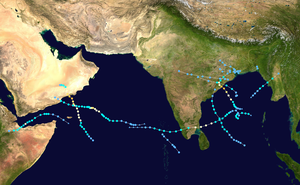| Timeline of the 2018 North Indian Ocean cyclone season | |||||
|---|---|---|---|---|---|
 Season summary map | |||||
| Season boundaries | |||||
| First system formed | March 13, 2018 | ||||
| Last system dissipated | December 17, 2018 | ||||
| Strongest system | |||||
| Name | Mekunu | ||||
| Maximum winds | 175 km/h (110 mph) (3-minute sustained) | ||||
| Lowest pressure | 960 hPa (mbar) | ||||
| Longest lasting system | |||||
| Name | Gaja | ||||
| Duration | 9.625 days | ||||
| |||||
The 2018 North Indian Ocean cyclone season was an above-average period of tropical cyclone formation in the Northern Indian Ocean. The season featured 14 depressions, 10 deep depressions, 7 cyclonic storms, 5 severe cyclonic storms, 4 very severe cyclonic storms, and 1 extremely severe cyclonic storm. The season has no official boundaries,[citation needed] though storms typically form between April and December, with peaks in tropical cyclone activity from May–June and in November.[1]
The India Meteorological Department (IMD) is the official Regional Specialized Meteorological Centre for the Northern Indian Ocean basin,[2] and as such, it is responsible for tracking and issuing advisories on systems in the Arabian Sea and in the Bay of Bengal.[3] If tropical cyclones in the Northern Indian Ocean reach winds of 34 kn (63 km/h; 39 mph), it is given a name from a pre-defined naming list.[4] The Joint Typhoon Warning Center (JTWC) unofficially issues advisories on systems in the Northern Indian Ocean,[5] assigning tropical cyclones a numerical identifier[6] and suffixing it with the letter A for systems in the Arabian Sra and B for systems in the Bay of Bengal.[7] The IMD measures tropical cyclone wind speeds over a 3-minute average[8] while the JTWC uses a 1-minute average.[6]
- ^ Kruk, Michael C. (September 1, 2019). "State of the Climate in 2018". North Indian Ocean Basin. Bulletin of the American Meteorological Society. 100 (9). American Meteorological Society: S127–S128. doi:10.1175/2019BAMSStateoftheClimate.1. hdl:10669/80308.
- ^ "Worldwide Tropical Cyclone Centers". National Hurricane Center. Miami, Florida. Retrieved August 24, 2021.
- ^ "Activities of RSMC, New Delhi". India Meteorological Department. Retrieved August 24, 2021.
- ^ Tropical Cyclone Operational Plan for the Bay of Bengal and the Arabian Sea: 2020 (Report). Geneva, Switzerland: World Meteorological Organization. 2020. p. 12. Retrieved August 24, 2021.
- ^ "Products and Services Notice". Joint Typhoon Warning Center. Pearl Harbor, Florida. Retrieved August 24, 2021.
- ^ a b "Frequently Asked Questions". Joint Typhoon Warning Center. Pearl Harbor, Florida. Retrieved August 24, 2021.
- ^ "North Indian Ocean Best Track Data". Joint Typhoon Warning Center. Pearl Harbor, Florida. Retrieved August 24, 2021.
- ^ Mohapatra, Mrutyunjay; et al., eds. (2016). WMO/ESCAP Panel on Tropical Cyclones Annual Review 2016 (PDF) (Report). World Meteorological Organization, United Nations Economic and Social Commission for Asia and the Pacific. p. ix. Retrieved August 25, 2021 – via India Meteorological Department.